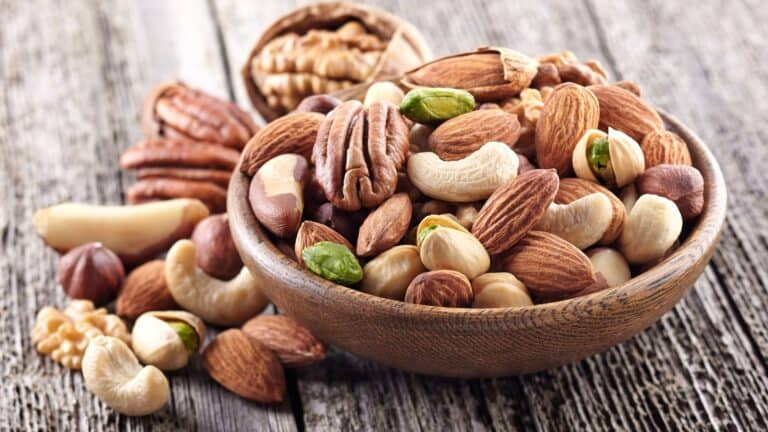14 Famous Brazilian Spices and Seasoning Blends
This post may contain affiliate links. Please see my disclosure policy for details.
Brazilian cuisine is famous for its delicious flavors and enchanting aromas. And the reason behind this is Brazilian spices and seasonings. Because of the influx of immigrants worldwide, Brazilian cuisine offers a mix of various cultures.
That’s why you’ll sense a touch of German, Arabic, Spanish, and Italian flavors in Brazilian dishes. Let’s explore some of the most famous Brazilian spices.
Brazilian Spices and Seasoning
As you go through these spices and seasonings, you will notice many dishes have their roots in other countries, especially Portugal.

1. Cinnamon
The enticing aroma and a mix of sweet and spicy flavors of cinnamon powder instill a unique taste in traditional Brazilian cuisine.
Brazilian Name: Canela
The Portuguese dish Frango assado is one of the flavorful examples that includes cinnamon as a special ingredient. It’s quite popular in Brazil.
Another famous Brazilian dish is Bolinhos de Chuva. These are small drop beignets that are rolled in cinnamon and sugar.
2. Clove
Brazilians developed a love for cloves in their cuisine from Portuguese cooking. And now Brazilians add cloves to so many dishes, including soups, pastries, and stews.
Brazilian Name: Cravo-da-India
This aromatic spice has flowery buds with pointed sticks on the knob-like head. With a distinct pungent yet deliciously sweet and spicy taste, cloves give an extraordinary aroma to various dishes.
Molho de cravo-da-Índia is a clove sauce used over steak. It is a rich and beautiful sauce that compliments beef well.
3. Nutmeg
Nutmeg is the inner fruit of the mace plant. The use of nutmeg in Brazil has come from Portuguese and European cuisines.
Brazilian Name: Noz Moscada
A tiny pinch of nutmeg is enough to induce an incredible flavor in different Brazilian dishes. But it is primarily used in desserts and hot drinks. But this doesn’t stop Brazilians from adding it to soups and curries/sauces.
4. Mint
First thing first, the aroma of fresh mint leaves is simply amazing. It’s one of my favorite things to add to drinks.

Brazilian Name: Hortela
With the addition of a few mint leaves in appetizers, salads, drinks, lamb dishes, and stuffed vegetables, the freshness and aesthetics of any dish go high.
However, if you can’t find fresh mint, use dried mint leaves. Dry mint will also work amazingly well in lamb or vegetable dishes.
Brazil has its own take on the popular Cuban Mojito. The Brazilian Mojito uses cachaça instead of rum.
5. Oregano
Brazilians love adding oregano to most of their dishes.

Although it came from Italian and Arabian cuisines, Brazilians have made it their ingredient. Sure, you will see it in the common dishes like pizza.
But we see it used in chimichurri, and tempero baiano Brazlian seasoning. Taking oregano to another level!
6. Cumin Powder
The next spice is cumin. Cumin powder infuses earthy, slightly bitter, and unique flavor into the food.
Brazilian Name: Cominho
Cumin is used throughout Brazilian cuisine. Barredo and cabrito ao molho are two of the most famous stews that use cumin as a special ingredient. A few other recipes are:
- Feijoada: This traditional Brazilian stew made with black beans, pork, and beef is often seasoned with cumin, along with other spices like bay leaves, garlic, and coriander.
- Moqueca: A Brazilian fish stew originating from the northeastern region of Bahia, Moqueca often includes cumin as a key spice, combined with ingredients like coconut milk, tomatoes, onions, and peppers.
- Carne de Sol: Cumin is used as a seasoning in this sun-dried, salted meat dish, which is typically served with rice, beans, and farofa (toasted cassava flour).
7. Pepper and Hot Sauce
Brazilians love to kick up the heat by using peppers and hot sauce.
Brazilian Name: Pimenta
Peppers are used all throughout South America and Spain. People from the Northern part of Brazil especially love hot sauces. For example, there is Molho apimentado which is made with cayenne pepper or malagueta peppers.
Then there is molho picante which can be made with red or green peppers.
As for popular peppers used in Brazil, here are some big ones:
Brazil is home to a wide variety of peppers that are used in its vibrant and flavorful cuisine. Here are four popular peppers commonly used in Brazilian cooking:
- Malagueta Pepper: This small, red pepper is one of the most widely used in Brazil. It has a medium to high heat level, ranging from 60,000 to 100,000 Scoville Heat Units (SHU). Malagueta peppers are often used in hot sauces, pickles, and as a seasoning for traditional dishes like moqueca and vatapá.
- Dedo de Moça (Lady’s Finger Pepper): Also known as “pimenta de bico” or “bird’s eye chili,” this pepper has a milder heat level, ranging from 15,000 to 30,000 SHU. Dedo de Moça peppers are used fresh or dried in various dishes, including sauces, stews, and marinades.
- Biquinho Pepper: This small, round, and red pepper has a unique shape resembling a bird’s beak, giving it its name. Biquinho peppers have a mild heat level, around 1,000 SHU, and are often used for pickling or as a garnish for salads and other dishes.
- Cumari Pepper: Cumari peppers are small, round, and yellow, with a fruity flavor and a high heat level, ranging from 50,000 to 300,000 SHU. They are commonly used in hot sauces, spice blends, and as a seasoning for grilled meats and fish.
8. Paprika
Paprika powder adds a mildly chilly flavor with a hint of sweetness. It’s basically the sister of the number #7.

Brazilian Name: Colorau
Though, it is not part of all the Brazilian recipes. Still, it is a must-required spice in Brazilian dishes like Acém Pimentada na Panela de Pressão which uses a hot paprika. But remember, paprika comes mild, hot, or smoked.
9. Allspice
Allspice is one of the most commonly used ingredients in Brazilian food.
Brazilian Name: Pimente de Jamaica
Allspice has the ability to go well in desserts, especially ones that use cinnamon, cloves, and nutmeg. But allspice also pairs very well with meats. With its naturally strong taste, this flavorful spice gives a rich flavor to the food.
The heat level and taste of allspice are like nutmeg, black pepper, and cinnamon. They bring nice warmth to a dish.
10. Bay Leaves
Bay leaves infuse a mild yet significant aroma into various Brazilian meat and fish dishes.

Brazilian Name: Louri
You will also see it used in soups and bean dishes. Bay leaves add a beautiful aroma. So, just 1-3 leaves are enough to make a huge difference in a dish. It’s a wonderful Brazilian spice to have in your pantry.
11. Pine Nuts
I bet you were not going to see a nut make the list on a Brazilian spices and seasonings but here we are! Pine nuts are highly nutritious. Plus, these are huge. Just for comparison, these nuts are approximately 4-6 times larger than the European version.
Brazilian Name: Pinhao
Furthermore, talking about the appearance, the color of pine nuts is dark brown. The taste of these nuts is sharp and strong. Additionally, the pine nuts are grown on the wonderfully erected pine trees in the Southern Hemisphere.
Pine nuts enhance the flavor of Brazilian cuisine. Moreover, wine made with Brazilian nuts is top-rated among native people for its fantastic flavor.
Here is some history on the Brazilian pine nut…
“The pine nut, which is the fruit of a pine tree hidden inside a woody structure known as a pine cone, is one of the oldest known foods of the human species. Anthropological studies show that the Stone Pine tree has been cultivated for its seeds (pine nuts) for at least 6,000 years, and that pine nuts have been harvested from wild trees for much, much longer. In North America, cultivation and harvest of pine nuts from the pinyon family of pines most likely goes back just as far, though the anthropological track record is not as easy to prove as it is in Europe.” (source)
12. Salt
Lastly, we have salt on the spice list (spice blends coming up next!)
Brazilian Name: Sal
Though it may seem unusual to include salt among the best Brazilian spices, surely any list containing Brazilian spices is incomplete without salt.
And this is because some Brazilian dishes only require salt and lemon or citrus. A good example of this is a salted caipirinha.
13. Bahian Seasoning Blend
We are now coming to the seasoning blends!
First, we got a Bahian seasoning blend. This seasoning blend adds a beautiful zest to several savory dishes, including stews, soups, seafood, chicken, and vegetables. This seasoning can also be used as a marinade.
It comes from the Bahian region of Brazil and is a blend of the following spices and herbs:
- Oregano
- Cumin
- Ground coriander
- Garlic powder
- Thyme
- Basil
- Paprika
- Onion powder
- Black pepper
- Cayenne pepper
- Nutmeg (Optional)
- Salt (to your taste)
14. Portuguese Dry Rub
Portuguese Dry Rub, also known as “tempero seco” in Portuguese, is a spice blend commonly used in Portugal and can also be found in Brazilian cuisine due to the shared cultural heritage between the two countries. This dry rub typically consists of spices such as paprika, garlic powder, onion powder, black pepper, salt, and sometimes cumin, coriander, or other herbs like parsley.
In Brazilian cooking, Portuguese Dry Rub can be used in various ways, including:
- Seasoning Meats: The dry rub can be used to marinate and season meats, poultry, and fish before grilling, baking, or pan-frying them. The blend adds a rich and savory flavor to the proteins, enhancing their taste.
- Rice and Bean Dishes: Brazilian rice and bean dishes, such as feijoada or traditional rice and beans, may incorporate Portuguese Dry Rub to add an extra layer of flavor and aroma to the dish.
- Stews and Soups: The dry rub can be added to stews like moqueca or caldeirada, as well as soups, to provide a depth of flavor with its combination of spices.
- Roasted Vegetables: Portuguese Dry Rub can be sprinkled on vegetables before roasting or grilling them, imparting a delicious and aromatic seasoning to the dish.
- Sauces and Dressings: The spice blend can also be mixed into sauces, dressings, or marinades to create a unique and flavorful addition to various dishes.
While Portuguese Dry Rub is not as widely used in Brazilian cuisine as it is in Portugal, it still serves as a versatile and flavorful seasoning option that can enhance a variety of dishes across different cooking methods.
Final Thoughts on Brazilian Spices
Brazilian cuisine is a rich tapestry of flavors and aromas, heavily influenced by the diverse cultures that have contributed to its unique identity. By exploring the wide variety of Brazilian spices and seasonings mentioned in this article, home cooks can transport their taste buds straight to the vibrant streets of Brazil!
From warm and earthy cumin to fiery malagueta peppers, these spices have the power to elevate any dish and make it truly unforgettable.
Don’t be afraid to experiment with these spices and blends in your own kitchen. Start by adding a touch of cinnamon to a dessert or marinating meats with Portuguese Dry Rub.
As you become more familiar with the flavors, you’ll discover endless possibilities for creating delicious and authentic Brazilian dishes at home.
So, take a culinary journey to the heart of Brazil and let these incredible spices and seasonings inspire your cooking adventures. Happy Cooking!






